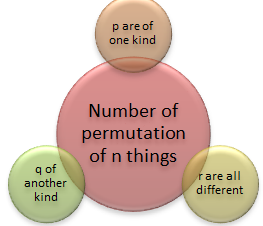Permutation of Alike Objects
There are two ways of permuting similar or like objects:
Case 1: Taken all at a time
Case 2: Taken some at a time
Suppose we have n distinct objects out of which n1 are of one type, n2 of second type and so on... nr are of r type, then the number of permutations is given by
n!/ (n1)!(n2)! ….. (nr)!
This can be explained by the following diagram:
Then the number of permutations taken all at a time are given by n!/p!q!r!
Complete Your Profile
View courses by askIITians


Design classes One-on-One in your own way with Top IITians/Medical Professionals
Click Here Know More

Complete Self Study Package designed by Industry Leading Experts
Click Here Know More

Live 1-1 coding classes to unleash the Creator in your Child
Click Here Know More

